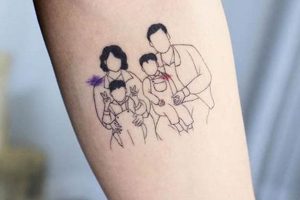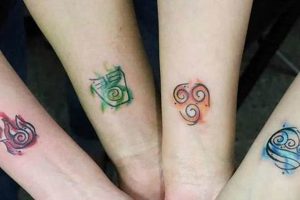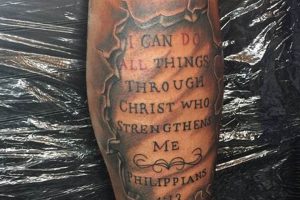Representing familial bonds through body art is a growing trend. These designs can range from minimalist symbols like intertwined hearts or initials to more complex artwork depicting family portraits, important dates, or shared hobbies and values. For example, a family sharing a love for the ocean might choose a wave motif, while another might honor their heritage with a symbolic representation of their ancestral homeland.
Permanent expressions of kinship offer a powerful visual reminder of connection and belonging. Such tattoos can serve as a source of comfort, strength, and inspiration, particularly during times of separation or difficulty. Historically, body markings have signified group affiliation and shared identity, and contemporary family-themed tattoos carry a similar weight, albeit with a more personalized expression. They serve as a modern testament to the enduring importance of familial ties.
Exploring the multifaceted nature of family-themed tattoos involves examining various design options, considering stylistic choices like realism, watercolor, or tribal art, and understanding the practicalities of placement, size, and color palette. The emotional significance and symbolic representation of these designs will also be addressed.
Tips for Meaningful Family Tattoos
Choosing a design that resonates with everyone involved requires careful consideration and planning. The following tips offer guidance for creating a meaningful and lasting tribute to familial bonds.
Tip 1: Collaborative Design: Open communication is crucial. Discuss ideas, preferences, and symbolism with all participating family members to ensure a design that reflects everyone’s vision.
Tip 2: Symbolic Representation: Explore symbols that embody shared values, memories, or inside jokes. Consider elements like birth flowers, meaningful quotes, or representative animals.
Tip 3: Style Considerations: Research various tattoo styles (e.g., minimalist, traditional, watercolor) and select one that complements the chosen design and individual preferences.
Tip 4: Placement and Size: Discuss placement and size collaboratively, considering factors like visibility, pain tolerance, and future design additions.
Tip 5: Color Palette: Choose colors that hold significance for the family or complement skin tones. Consider the long-term impact of color choices as ink fades over time.
Tip 6: Research Artists: Carefully vet potential tattoo artists, focusing on their portfolios, specialization, and hygiene practices. Choose an artist whose style aligns with the desired design.
Tip 7: Budgetary Planning: Discuss budget constraints openly with the chosen artist to ensure expectations align with financial realities.
Thoughtful planning and open communication are essential to creating meaningful family tattoos that will be cherished for years to come. By following these tips, families can ensure a collaborative and fulfilling experience, resulting in beautiful and enduring representations of their bond.
These considerations pave the way for a tattoo that serves as a lasting symbol of familial connection, reflecting shared values and memories.
Shared symbolism forms the cornerstone of successful family tattoos. A design’s resonance stems from its ability to evoke shared experiences, values, or inside jokes unique to the family unit. This shared understanding transforms a simple image into a potent symbol of connection and belonging. A family’s shared love for camping, for instance, could be represented by a stylized campfire, while a quote from a beloved grandparent could serve as a constant reminder of their influence and legacy. The symbolic element acts as a visual shorthand, communicating a wealth of meaning understood only by those within the family circle.
This shared meaning also strengthens familial bonds. Choosing a symbol collaboratively, discussing its significance, and ultimately wearing it permanently reinforces a sense of unity and shared identity. The process of selecting the symbol itself can become a valuable opportunity for families to reflect on their history, values, and aspirations. For example, siblings might choose matching coordinates representing their childhood home, a tangible reminder of shared roots and formative experiences. Alternatively, a family might select a symbol representing resilience after overcoming a difficult period, turning a challenging memory into a symbol of strength and mutual support.
Selecting a meaningful symbol is crucial to achieving a successful family tattoo. This shared language, etched onto the skin, becomes more than mere decoration; it transforms into a powerful emblem of kinship and belonging. It underscores the importance of careful consideration and open communication during the design process, ensuring the chosen symbol authentically represents the unique narrative of the family. This deepens the emotional connection to the tattoo, ensuring it remains a cherished symbol of familial unity for years to come.
2. Collaborative Design
Collaborative design plays a crucial role in creating successful family tattoos. Open communication and shared decision-making ensure the final design resonates with every individual involved, fostering a sense of unity and shared ownership. This collaborative approach transforms the tattoo from a mere individual statement into a powerful symbol of familial connection.
- Idea Generation & Brainstorming
Initial brainstorming sessions allow family members to contribute ideas, share inspirations, and discuss potential themes. This open exchange fosters creativity and ensures diverse perspectives are considered. For example, one family member might suggest incorporating birth flowers, while another proposes a design based on a shared childhood memory. This collective input builds a foundation for a design that reflects the family’s unique narrative.
- Symbolism & Meaning
Collaborative discussions around symbolism are essential. Family members must agree on the meaning and significance of chosen elements. A symbol meaningful to one individual might hold a different connotation for another. For instance, a specific animal might represent strength to one sibling but hold a negative association for another. Open dialogue ensures shared understanding and prevents misinterpretations, resulting in a design that carries genuine collective significance.
- Design Refinement & Feedback
Throughout the design process, ongoing feedback is crucial. Sharing sketches, revisions, and digital mockups allows each family member to contribute refinements and ensure the design aligns with their vision. This iterative process allows for adjustments, ensuring the final design reflects the collective aesthetic preferences and symbolic intentions of the family.
- Artist Selection & Communication
Choosing a tattoo artist collaboratively ensures everyone feels comfortable with the artist’s style and experience. Joint consultations and portfolio reviews allow family members to discuss preferences, ask questions, and establish clear communication with the chosen artist. This collaborative approach minimizes potential misunderstandings and fosters a sense of trust, contributing to a positive and successful tattooing experience.
By embracing collaborative design principles, families can create tattoos that authentically represent their shared history, values, and aspirations. This shared ownership of the design process enhances the emotional significance of the final piece, solidifying the tattoo as a powerful and enduring symbol of familial bond.
3. Thoughtful Placement
Thoughtful placement is integral to successful family tattoos. Placement decisions impact not only aesthetic appeal but also practicality and personal significance. Consideration must be given to visibility preferences, pain tolerance, and the potential for future design additions. A family might opt for a discreet location, such as the inner wrist or ankle, for a more private symbol of connection. Alternatively, a more visible placement, like the forearm or shoulder, could serve as a proud declaration of familial unity. Placement choices can also reflect the specific symbolism of the tattoo. For example, a tattoo honoring a deceased parent might be placed close to the heart, while a design representing shared growth could be placed on the back, symbolizing support and strength.
Practical considerations influence placement choices. Areas of the body that experience frequent friction or sun exposure might not be ideal for certain designs or individuals. Pain tolerance also varies across body regions, influencing placement choices. Furthermore, families should consider the potential for future additions to the tattoo. Choosing a location that allows for seamless expansion of the design enables the narrative to evolve over time, reflecting new shared experiences or the addition of new family members. For instance, a family tree design might begin with a single branch, with additional branches added later to represent new generations. This foresight allows the tattoo to grow and adapt alongside the family itself.
Careful consideration of placement transforms a family tattoo into a more personalized and meaningful expression of kinship. It demonstrates an understanding of individual preferences, practicality, and the potential for future adaptation. Thoughtful placement ensures the tattoo remains a source of pride and connection for years to come, reflecting the evolving narrative of the family unit. This attention to detail elevates the tattoo beyond mere aesthetics, transforming it into a powerful and enduring symbol of familial bonds.
4. Appropriate Sizing
Appropriate sizing is a critical factor in the success of family-themed tattoos. Size directly impacts legibility, aesthetic balance, and the overall impact of the design. A well-sized tattoo complements the chosen design and the individual’s body, ensuring the artwork remains clear and visually appealing for years to come. Careful consideration of size is essential for achieving a harmonious and lasting tribute to familial bonds.
- Scale and Detail
Intricate designs with fine details necessitate sufficient size for clear execution. A small-scale rendition of a complex image might result in blurred lines and lost detail over time. Conversely, simpler designs can retain their impact even at smaller sizes. For example, a detailed family portrait requires ample space to capture individual features, while a single initial or small symbol can be effectively rendered in a smaller, more discreet size.
- Body Placement and Proportions
Tattoo size should be proportionate to the chosen body part. A large, sprawling design might overwhelm a delicate wrist, while a tiny tattoo could get lost on a broad back. The size should complement the natural contours of the body and harmonize with the individual’s physique. For instance, a band of names encircling a bicep requires careful sizing to avoid distortion, while a small symbolic image might be better suited to the inner ankle.
- Visual Impact and Legibility
The desired visual impact influences size considerations. A bold statement piece demands a larger scale to command attention, while a subtle, intimate design might be more effective at a smaller size. Legibility is also a factor, especially for tattoos incorporating text or intricate details. A name or quote, for example, needs to be large enough to remain readable as the tattoo ages.
- Long-Term Considerations
Tattoos tend to spread and fade slightly over time. Appropriate sizing accounts for these changes, ensuring the design retains its clarity and impact. A tattoo sized too small might become illegible as lines blur, while a very large tattoo might lose definition as the ink spreads. Choosing a size that allows for these natural changes ensures the tattoo remains aesthetically pleasing in the long run.
By carefully considering these factors, families can ensure their chosen designs are rendered in a size that enhances their aesthetic appeal, legibility, and longevity. Appropriate sizing contributes significantly to the overall success of a family tattoo, ensuring it remains a cherished symbol of connection for years to come. This careful consideration demonstrates respect for the design, the individual wearing it, and the enduring nature of familial bonds.
5. Harmonious Style
Harmonious style is a critical element in creating successful family tattoos. A cohesive aesthetic strengthens the visual representation of unity, ensuring the design reflects a shared sensibility and strengthens the familial bond it symbolizes. Selecting a style that resonates with all participating family members requires careful consideration of individual preferences and the overall message the tattoo aims to convey. A consistent style unifies the design, transforming individual elements into a cohesive whole.
- Unified Aesthetic
A unified aesthetic creates a sense of visual coherence and balance. Whether the family chooses a minimalist approach with clean lines and simple symbols or a more elaborate style like realism or watercolor, consistency in style across all elements is essential. For instance, incorporating elements of both tribal and floral styles within a single design might create a disjointed aesthetic, whereas adhering to a single style, like traditional Japanese or neo-traditional, produces a more harmonious and visually appealing result.
- Individual Preferences & Shared Vision
While maintaining a harmonious style, individual preferences can still be accommodated. Subtle variations within a chosen style can reflect individual personalities while maintaining overall cohesion. For example, if a family chooses a traditional style, individual elements can be customized with slight variations in color or shading to represent each person’s unique characteristics. This approach allows for personal expression while upholding a unified aesthetic.
- Symbolic Representation & Style Choice
The chosen style should complement the symbolic meaning of the tattoo. A delicate, intricate design might be appropriate for a tattoo symbolizing nurturing and protection, while a bolder, more graphic style might be better suited for a design representing strength and resilience. For instance, a family choosing a tree as a symbol of growth and interconnectedness might opt for a flowing, organic style, whereas a family honoring a shared passion for music might prefer a more geometric, structured style reflecting musical notation or instruments.
- Long-Term Considerations & Style Trends
While current trends might seem appealing, considering the longevity of a tattoo is paramount. Classic styles tend to age better than highly stylized or trendy designs. A style that might be fashionable today could look dated in a few years. Choosing a timeless style, such as traditional or blackwork, ensures the tattoo remains aesthetically pleasing for decades to come. This long-term perspective ensures the tattoo remains a cherished symbol of familial connection, regardless of changing trends.
Harmonious style in family tattoos is not merely an aesthetic consideration; it reflects the deeper unity and shared values of the family itself. By carefully selecting a style that resonates with everyone and complements the chosen symbolism, families create a lasting visual representation of their bond, a powerful symbol of connection that endures through time.
6. Skilled Artist Selection
Skilled artist selection is paramount when realizing family tattoo concepts. A skilled artist translates abstract ideas into tangible, aesthetically pleasing, and enduring artwork. The technical expertise influences the final product’s quality, longevity, and ability to accurately represent the family’s vision. An artist’s proficiency in line work, shading, and color saturation directly impacts the tattoo’s visual appeal and resistance to fading over time. For example, an artist specializing in fine linework excels at intricate designs, while a realism specialist captures nuanced details in portrait-style tattoos. Choosing an artist whose skill set aligns with the desired style and complexity ensures a successful outcome. Conversely, an inexperienced artist might struggle with intricate details or consistent linework, compromising the tattoo’s aesthetic integrity and potentially leading to costly and time-consuming corrections.
Beyond technical proficiency, a skilled artist possesses strong communication and collaborative skills. Effective communication bridges the gap between concept and execution. The artist clarifies design elements, offers professional guidance on placement and sizing, and addresses any concerns throughout the process. This collaborative approach ensures the final design aligns with the family’s shared vision. For instance, a skilled artist advises on the optimal placement for a multi-element design, ensuring visual balance and accommodating the natural contours of the body. They might also suggest modifications to the design to enhance its longevity, such as simplifying overly intricate details or adjusting the color palette for optimal ink retention. This collaborative process fosters trust and ensures a positive experience for all involved.
Ultimately, skilled artist selection safeguards the investment, both emotional and financial, inherent in family tattoos. A well-executed tattoo becomes a cherished symbol of familial connection, enduring for generations. Choosing a skilled artist mitigates the risk of unsatisfactory results, minimizing the need for costly and often painful removals or cover-ups. Thorough research, portfolio reviews, and consultations are essential steps in selecting an artist capable of transforming a family’s vision into a beautiful and lasting piece of art. This careful selection process demonstrates respect for the significance of the tattoo and ensures a positive and fulfilling experience for all involved, strengthening the familial bond the tattoo represents.
7. Meaningful Color Palette
Color imbues family tattoos with deeper meaning, transforming simple designs into vibrant expressions of shared history and values. A meaningful color palette transcends mere aesthetics; it amplifies the emotional resonance of the tattoo, connecting it to shared memories, individual personalities, and the unique narrative of the family. Careful color selection elevates the tattoo from a visual representation to a powerful symbol of kinship and belonging.
- Shared Experiences and Memories
Colors evoke powerful associations, linking the tattoo to shared experiences and memories. A family who spent summers at the beach might choose shades of blue and green to represent the ocean and sky, forever associating those colors with cherished moments of togetherness. Similarly, colors associated with a beloved family member’s personality or favorite things can serve as a lasting tribute, keeping their memory vivid and present. This connection between color and memory transforms the tattoo into a tangible reminder of shared experiences and strengthens the familial bond.
- Individual Personalities and Birthstones
Incorporating individual birthstones or favorite colors celebrates the unique personalities within the family while maintaining a unified design. Each color adds a personal touch, representing individual contributions to the family dynamic. For example, siblings might incorporate their respective birthstones into a shared design, representing their individuality within the larger family unit. This personalized approach ensures each member feels seen and represented, strengthening the sense of belonging.
- Cultural and Symbolic Significance
Colors carry cultural and symbolic weight, adding layers of meaning to the tattoo. Specific colors might represent values, beliefs, or traditions important to the family. For example, red might symbolize passion and love, while green might represent growth and harmony. Incorporating these symbolic colors adds depth and complexity to the design, enriching its narrative and reflecting the family’s shared cultural heritage.
- Long-Term Vibrancy and Colorfastness
Considering the long-term vibrancy and colorfastness of different inks is essential. Certain colors fade more quickly than others, particularly lighter shades. Consulting with a skilled tattoo artist ensures informed color choices that maintain their impact over time. For instance, darker, more saturated colors tend to hold their vibrancy longer than pastel shades, which might fade or become less defined over time. This foresight ensures the tattoo remains a vibrant and meaningful representation of familial bonds for years to come.
A meaningful color palette elevates family tattoos beyond mere decoration. It transforms them into powerful narratives, rich with shared experiences, individual personalities, and enduring familial bonds. The thoughtful selection of color reinforces the symbolic meaning of the design, ensuring the tattoo remains a cherished representation of kinship for generations to come.
Frequently Asked Questions
Individuals considering family-themed tattoos often have several important questions. Addressing these common queries provides clarity and facilitates informed decision-making.
Question 1: How can families ensure everyone agrees on a design?
Open communication and collaborative brainstorming are crucial. Each family member should contribute ideas and express preferences. Compromise and flexibility are essential for reaching a consensus.
Question 2: What are suitable symbols for family tattoos?
Suitable symbols reflect shared values, memories, or inside jokes. Options include birth flowers, meaningful quotes, representative animals, or significant dates rendered in Roman numerals.
Question 3: How does one choose an appropriate tattoo style?
Style selection depends on individual preferences and the overall design concept. Research various styles, considering factors like linework, shading, and color palettes. Consult a skilled tattoo artist for guidance.
Question 4: What factors influence placement decisions?
Placement depends on visibility preferences, pain tolerance, and potential future additions. Practical considerations include areas prone to friction or sun exposure. Symbolic meaning can also influence placement choices.
Question 5: How does one determine the appropriate size?
Size should complement the chosen design, body placement, and desired visual impact. Intricate details require larger sizes for clarity. Proportionality to the body part is crucial for aesthetic balance.
Question 6: How important is artist selection?
Artist selection is critical. A skilled artist possesses technical proficiency, artistic vision, and strong communication skills. Thorough research, portfolio reviews, and consultations are essential for finding a suitable artist.
Careful consideration of these questions ensures a positive and fulfilling experience, resulting in a meaningful and lasting tribute to familial bonds.
Understanding the process and potential challenges allows individuals to approach family-themed tattoos with realistic expectations and make informed decisions.
Conclusion
Thoughtful design choices are paramount for tattoos symbolizing familial connections. Careful consideration of shared symbolism, collaborative design processes, appropriate placement and sizing, harmonious style selection, skilled artist selection, and meaningful color palettes ensures a powerful and lasting tribute. These elements transform simple body art into profound expressions of kinship, reflecting the unique narrative of each family.
Ultimately, successful family tattoos transcend mere aesthetics; they embody shared histories, values, and the enduring power of familial bonds. These permanent markings serve as constant reminders of connection, belonging, and the strength derived from shared experiences. The process of choosing and realizing these designs can itself strengthen familial ties, creating lasting memories and solidifying the very bonds they represent.







